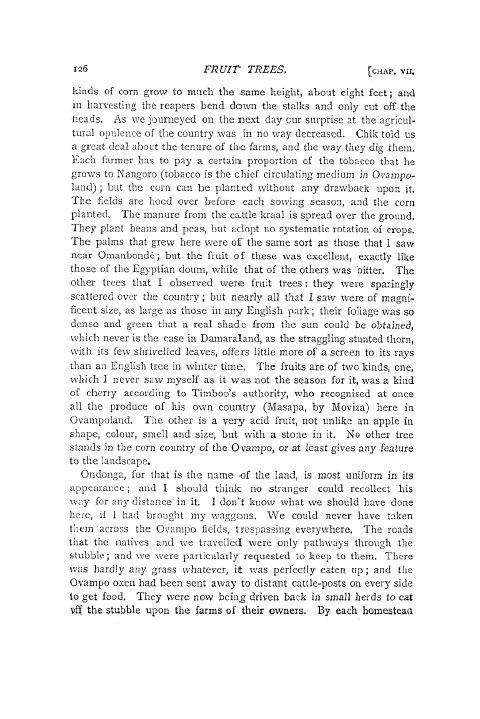126 FRUIT TREES. [creep. VII.
kinds of corn grow to much the same height, about eight feet ; and
harvesting the reapers bend down the stalks and only cut off the treads. As we journeyed on the next day our surprise at the agricultural opulence of the country was in no way decreased. Chik told us a great deal about the tenure of the farms, and the way they dig them. Each farmer has to pay a certain proportion of the tobacco that he grows to Nangoro (tobacco is the chief circulating medium in Ovampoland) ; but the corn can be planted without any drawback upon it. The fields are hoed over before each sowing season, and the corn planted. The manure from the cattle kraal is spread over the ground. They plant beans and peas, but adopt no systematic rotation of crops. The palms that grew here were of the same sort as those that I saw near Omanbondc; but the fruit of these was excellent, exactly like those of the Egyptian doum, while that of the others was bitter. The other trees that I observed were fruit trees : they were sparingly scattered over the country ; but nearly all that I saw were of magnificent size, as large as those in any English park; their foliage was so dense and green that a real shade from the sun could be obtained, which never is the case in Damaraland, as the straggling stunted thorn, with its few shrivelled leaves, offers little more of a screen to its rays than an English tree in winter time. The fruits are of two kinds, one, which I never saw myself as it was not the season for it, was a kind of cherry according to Timboo's authority, who recognised at once all the produce of his own country (Masapa, by Moviza) here in Ovampoland. The other is a very acid fruit, not unlike an apple in shape, colour, smell and size, but with a stone in it. No other tree stands in the corn country of the Ovampo, or at least gives any feature to the landscape.
Ondonga, for that is the name of the land, is most uniform in its appearance;, and I should think no stranger could recollect his way for any distance in it. I don't know what we should have done here, if I had brought my waggons. We could never have taken them across the Ovampo fields, trespassing everywhere. The roads that the natives and we travelled were only pathways through the stubble; and we were particularly requested to keep to them. There was hardly any grass whatever, it was perfectly eaten. tip ; and the Ovampo oxen had been sent away to distant cattle-posts on every side to get food. They were now being driven back in small herds to eat vff the stubble upon the farms of their owners. By each homesteaa

